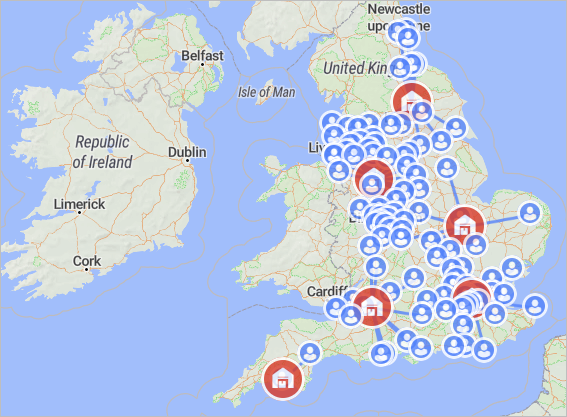In this example, we will learn how to find the required number of warehouses to keep the service distance within specific limits. The example also shows how to find locations of distribution centers considering only cities with the defined minimum population.
Drugstores executive management decided to rent new facilities for its cold chain. Effective supply chain management is a complex task, which presupposes keeping inventory policies balanced, while cutting operational costs, including transportation and distribution expenses.
This problem can be solved by completing several steps. Every step is an example model that will explain changes made in the supply chain. These models are:
- GFA Cold Chain — a scenario for finding warehouse locations using Greenfield Analysis.
- GFA Cold Chain (Multi-Echelon) — a scenario for finding a location of the main distribution center based on warehouse locations.
- SIM Cold Chain (Safety Stock Estimation) — a scenario for adjusting inventory policies to decrease carrying cost and improve Service level.
- SIM Cold Chain (Risk Analysis) — a scenario for testing the supply chain, constructed in previous steps in case of unpredicted events occurring.
This example is the first step of the sequence: Greenfield Analysis is used to find optimal number of sites as well as to define the approximate locations considering minimum input data:
- Customers locations
- List of products
- Aggregated demand for each customer
We consider a supply chain in England comprising
- 100 drugstores located in the largest cities of England.
Demand for the following drugs is of periodic nature: antihistamines, vitamins, stomachic medications, cardiac medications, analgesics, reliever medications, ophthalmic, neurological drugs, and cold medicines.
The customers should be located within the range of 100 km from the facilities.
Find optimal number of regional sites and define their locations.
The result of the GFA experiment offers to add six new warehouses to the supply chain throughout England. Since we know the required number of warehouses to have the service distance within 100 km, let us run the GFA with roads experiment to improve locations of distribution centers to consider roads and cities. Define the Number of sites in the settings of GFA with roads experiment and run it. The found locations will be used to open new warehouses.

The data on product flows, distance coverage by demand and demand coverage by distance is given in the corresponding tables:
- Product Flows — shows detailed statistics on the flows of the supply chain within the specified period of time.
- New Site Locations — shows information on all the new sites created by the experiment.
- Distance Coverage by Demand — shows detailed statistics on the distance to cover to satisfy a certain percentage of the demand.
- Demand Coverage by Distance (and total demand) — shows detailed statistics on the demand to satisfy within a certain distance per site created by the GFA experiment.
In the next step of this sequence (GFA Cold Chain (Multi-Echelon)) we will find a location for the distribution center, which will supply regional warehouses.
-
How can we improve this article?
-

